Gold mining
History

It is impossible to know the exact date that humans first began to mine gold, but some of the oldest known gold artifacts were found in the Varna Necropolis in Bulgaria. The graves of the necropolis were built between 4700 and 4200 BC, indicating that gold mining could be at least 7000 years old.[1] A group of German and Georgian archaeologists claims the Sakdrisi site in southern Georgia, dating to the 3rd or 4th millennium BC, may be the world's oldest known gold mine.[2]
.TIF.jpg)
Bronze Age gold objects are plentiful, especially in Ireland and Spain, and there are several well known possible sources. Romans used hydraulic mining methods, such as hushing and ground sluicing on a large scale to extract gold from extensive alluvial (loose sediment) deposits, such as those at Las Medulas. Mining was under the control of the state but the mines may have been leased to civilian contractors some time later. The gold served as the primary medium of exchange within the empire, and was an important motive in the Roman invasion of Britain by Claudius in the first century AD, although there is only one known Roman gold mine at Dolaucothi in west Wales. Gold was a prime motivation for the campaign in Dacia when the Romans invaded Transylvania in what is now modern Romania in the second century AD. The legions were led by the emperor Trajan, and their exploits are shown on Trajan's Column in Rome and the several reproductions of the column elsewhere (such as the Victoria and Albert Museum in London).[3] Under the Eastern Roman Empire Emperor Justinian's rule, gold was mined in the Balkans, Anatolia, Armenia, Egypt, and Nubia.[4]
In the area of the Kolar Gold Fields in Bangarpet Taluk, Kolar District of Karnataka state, India, gold was first mined prior to the 2nd and 3rd century AD by digging small pits. (Golden objects found in Harappa and Mohenjo-daro have been traced to Kolar through the analysis of impurities — the impurities include 11% silver concentration, found only in KGF ore.) The Champion reef at the Kolar gold fields was mined to a depth of 50 metres (160 ft) during the Gupta period in the fifth century AD. During the Chola period in the 9th and 10th century AD, the scale of the operation grew. The metal continued to be mined by the eleventh century kings of South India, the Vijayanagara Empire from 1336 to 1560, and later by Tipu Sultan, the king of Mysore state and the British. It is estimated that the total gold production in Karnataka to date is 1000 tons.[5]
The mining of the Hungarian deposit (present-day Slovakia) primarily around Kremnica was the largest of the Medieval period in Europe.[6]
During the 19th century, numerous gold rushes in remote regions around the globe caused large migrations of miners, such as the California Gold Rush of 1849, the Victorian Gold Rush, and the Klondike Gold Rush. The discovery of gold in the Witwatersrand led to the Second Boer War and ultimately the founding of South Africa.
The Carlin Trend of Nevada, U.S., was discovered in 1961. Official estimates indicate that total world gold production since the beginning of civilization has been around 6,109,928,000 troy ounces (190,040.0 t) and total gold production in Nevada is 2.5% of that, ranking Nevada as one of the Earth's primary gold producing regions.[7][8]
As of 2017, the world's largest gold producer by far was China with 429.4 tonnes in that year. The second-largest producer, Australia, mined 289.0 tonnes in the same year, followed by Russia with 273 tonnes.[9]
Statistics
Despite the decreasing gold content of ores, the production is increasing. This can be achieved with industrial installations, and new process, like hydrometallurgy.
{Gallery |align= center |File:Top 5 Gold Producers.png|Trends in some gold-producing countries |File:World Gold Production 1900-2014.png|Annual world mined gold production, 1900-2014 |file:Evolution mineral or gold panning|Gold is a grade evolution}
Methods
Placer mining
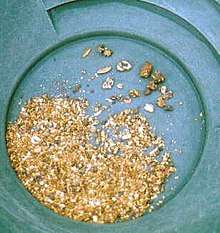
Placer mining is the technique by which gold that has accumulated in a placer deposit is extracted. Placer deposits are composed of relatively loose material that makes tunneling difficult, and so most means of extracting it involve the use of water or dredging.
Panning
Gold panning is mostly a manual technique of separating gold from other materials. Wide, shallow pans are filled with sand and gravel that may contain gold. The pan is submerged in water and shaken, sorting the gold from the gravel and other material. As gold is much denser than rock, it quickly settles to the bottom of the pan. The panning material is usually removed from stream beds, often at the inside turn in the stream, or from the bedrock shelf of the stream, where the density of gold allows it to concentrate, a type called placer deposits.
Gold panning is the easiest and quickest technique for searching for gold, but is not commercially viable for extracting gold from large deposits, except where labor costs are very low or gold traces are substantial. Panning is often marketed as a tourist attraction on former gold fields. Before large production methods are used, a new source must be identified and panning is useful to identify placer gold deposits to be evaluated for commercial viability.
Sluicing
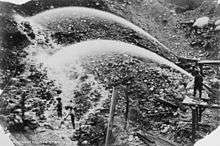
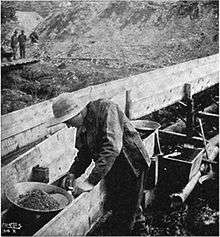
Using a sluice box to extract gold from placer deposits has long been a very common practice in prospecting and small-scale mining. A sluice box is essentially a man made channel with riffles set in the bottom. The riffles are designed to create dead zones in the current to allow gold to drop out of suspension. The box is placed in the stream to channel water flow. Gold-bearing material is placed at the top of the box. The material is carried by the current through the volt where gold and other dense material settles out behind the riffles. Less dense material flows out of the box as tailings.
Larger commercial placer mining operations employ screening plants, or trommels, to remove the larger alluvial materials such as boulders and gravel, before concentrating the remainder in a sluice box or jig plant. These operations typically include diesel powered, earth moving equipment, including excavators, bulldozers, wheel loaders, and rock trucks.
Dredging
Although this method has largely been replaced by modern methods, some dredging is done by small-scale miners using suction dredges. These are small machines that float on the water and are usually operated by one or two people. A suction dredge consists of a sluice box supported by pontoons, attached to a suction hose which is controlled by a miner working beneath the water.
State dredging permits in many of the United States gold dredging areas specify a seasonal time period and area closures to avoid conflicts between dredgers and the spawning time of fish populations. Some states, such as Montana, require an extensive permitting procedure, including permits from the U.S. Corps of Engineers, the Montana Department of Environmental Quality, and the local county water quality boards.
Some large suction dredges (100 horsepower (75 kW) & 250 mm (10 in)) are used in commercial production throughout the world. Small suction dredges are much more efficient at extracting smaller gold than the old bucket line. This has improved the chances of finding gold. Smaller dredges with 50-to-100-millimetre (2 to 4 in) suction tubes are used to sample areas behind boulders and along potential pay streaks, until "colour" (gold) appears.
Other larger scale dredging operations take place on exposed river gravel bars at seasonal low water. These operations typically use a land based excavator to feed a gravel screening plant and sluice box floating in a temporary pond. The pond is excavated in the gravel bar and filled from the natural water table. "Pay" gravel is excavated from the front face of the pond and processed through the floating plant, with the gold trapped in the onboard sluice box and tailings stacked behind the plant, steadily filling in the back of the pond as the operation moves forward. This type of gold mining is characterized by its low cost, as each rock is moved only once. It also has low environmental impact, as no stripping of vegetation or overburden is necessary, and all process water is fully recycled. Such operations are typical on New Zealand's South Island and in the Klondike region of Canada.
Rocker box
Also called a cradle, it uses riffles located in a high-walled box to trap gold in a similar manner to the sluice box. A rocker box uses less water than a sluice box and is well suited for areas where water is limited. A rocking motion provides the water movement needed for the gravity separation of gold in placer material.
Hard rock mining
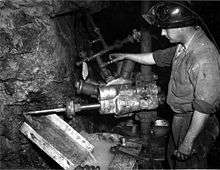
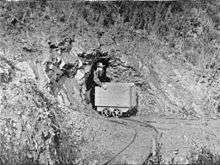
Hard rock gold mining extracts gold encased in rock, rather than fragments in loose sediment, and produces most of the world's gold. Sometimes open-pit mining is used, such as at the Fort Knox Mine in central Alaska. Barrick Gold Corporation has one of the largest open-pit gold mines in North America located on its Goldstrike mine property in north eastern Nevada. Other gold mines use underground mining, where the ore is extracted through tunnels or shafts. South Africa has the world's deepest hard rock gold mine up to 3,900 metres (12,800 ft) underground. At such depths, the heat is unbearable for humans, and air conditioning is required for the safety of the workers. The first such mine to receive air conditioning was Robinson Deep, at that time the deepest mine in the world for any mineral.[10]
By-product gold mining
Gold is also produced by mining in which it is not the principal product. Large copper mines, such as the Bingham Canyon mine in Utah, often recover considerable amounts of gold and other metals along with copper. Some sand and gravel pits, such as those around Denver, Colorado, may recover small amounts of gold in their wash operations. The largest producing gold mine in the world, the Grasberg mine in Papua, Indonesia, is primarily a copper mine.[11]
A modest amount of precious metal is a by-product of sodium production.
Gold ore processing
In placer mines, the gold is recovered by gravity separation. For hard rock mining, other methods are usually used.[12]
Cyanide process
Cyanide extraction of gold may be used in areas where fine gold-bearing rocks are found. Sodium cyanide solution is mixed with finely ground rock that is proven to contain gold or silver, and is then separated from the ground rock as gold cyanide or silver cyanide solution. Zinc is added to precipitate out residual zinc as well as the silver and gold metals. The zinc is removed with sulfuric acid, leaving a silver or gold sludge that is generally smelted into an ingot then shipped to a metals refinery for final processing into 99.9999% pure metals.
Advancements in the 1970s have seen activated carbon used in extracting gold from the leach solution. The gold is absorbed into the porous matrix of the carbon. Activated carbon has so much internal surface area,[13] that fifteen grams of it has the equivalent surface area of the Melbourne Cricket Ground (18,100 square metres (195,000 sq ft)). The gold can be removed from the carbon by using a strong solution of caustic soda and cyanide, a process known as elution. Gold is then plated out onto steel wool through electrowinning. Gold specific resins can also be used in place of activated carbon, or where selective separation of gold from copper or other dissolved metals is required.
The technique using dissolution with alkaline cyanide has been highly developed over recent years. It is particularly appropriate for low grade gold and silver ore processing (e.g. less than 5 ppm gold) but its use is not restricted to such ores. There are many environmental hazards associated with this extraction method, largely due to the high acute toxicity of the cyanide compounds involved. A major example of this hazard was demonstrated in the 2000 Baia Mare cyanide spill, when a break in holding pond dam at a mine waste reprocessing facility near Baia Mare in northern Romania released approximately 100,000 cubic metres (3,500,000 cu ft) of waste water contaminated with heavy metal sludge and up to 120 long tons (122 t) of cyanide into the Tisza River.[14] As a consequence, most countries now have strict regulations for cyanide in plant discharges, and plants today include a specific cyanide-destruction step before discharging their tailings to a storage facility.
Mercury process
Historically, mercury was used extensively in placer gold mining in order to form mercury-gold amalgam with smaller gold particles, and thereby increase the gold recovery rates. Large-scale use of mercury stopped in the 1960s. However, mercury is still used in artisanal and small-scale gold mining (ASGM), often clandestine, gold prospecting.[15] It is estimated that 45,000 metric tons of mercury used in California for placer mining have not been recovered.
Business
Small operations

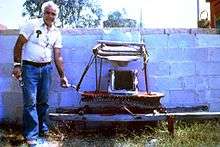
While most of the gold is produced by major corporations, millions of people work independently in smaller, artisan operations, in some cases illegally. Artisanal mining refers to workers who use rudimentary methods to extract and process minerals and metals. Socially and economically marginalized communities mine to escape extreme poverty, unemployment and landlessness.
In Ghana, the galamseys are estimated to number 20,000 to 50,000.[16] In neighboring francophone countries, such workers are called orpailleurs. In Brazil, such workers are called garimpeiros.
There are an estimated 10 to 15 million artisanal and small-scale gold miners worldwide. 4.5 million of them are women. Miner’s risks include persecution by government, mine shaft collapses, and toxic poisoning from unsafe chemicals used in processing.
The high risk of such ventures was seen in the collapse of an illegal mine at Dompoase, Ashanti Region, Ghana, on 12 November 2009, when 18 workers were killed, including 13 women. Many women work at such mines as porters. It was the worst mining disaster in Ghanaian history.[16]
In order to maximize gold extraction, mercury is often used to amalgamate with the metal. The gold is produced by boiling away the mercury from the amalgam. Mercury is effective in extracting very small gold particles, but the process is hazardous due to the toxicity of mercury vapour.
Especially after the Minamata Convention has been ratified, there are initiatives to replace or reduce the use and emissions of mercury in the extraction of gold.[17]
There are an estimated 600,000 children working in illegal artisanal gold mines.
For hours, children dig, crush, mill, and haul ore in the hot sun. Children stand in water, digging sand and silt from riverbeds. They carry heavy bags of mud with their heads to designated sieving and washing sites. Children suffer the effects of noise, vibration, overexertion, poor ventilation, and exhaustion. Children’s lives are put at risk by rock fall, explosions, the collapsing of tunnels and mine shafts, falling into open shafts and pits, and breathing air polluted by dust and toxic gas. Having immune systems that are not fully developed makes children especially vulnerable to dust and chemical exposure. Injuries include serious respiratory conditions, constant headaches, hearing and sight problems, joint disorders and various dermatological, muscular and orthopaedic ailments and wounds.
Large companies
Barrick Gold, Goldcorp, Newmont Mining Corporation, Newcrest Mining, and AngloGold Ashanti are the world's five largest gold mining companies by market capitalisation in 2008.
Adverse effects
Gold mining can significantly alter the natural environment. For example, gold mining activities in tropical forests are increasingly causing deforestation along rivers and in remote areas rich in biodiversity.[18][19] Other gold mining impacts, particularly in aquatic systems with residual cyanide or mercury (used in the recovery of gold from ore), can be highly toxic to people and wildlife even at relatively low concentrations.[20]
However, there are clear moves by many in the non-governmental organization community to encourage more environmentally friendly and sustainable business practices in the mining industry. The primary way this is being achieved is via the promotion of so-called 'clean' or 'ethical' gold. The aim is to get all end users/retailers of gold to adhere to set of principles that encourage sustainable mining. Campaigns such as 'No Dirty Gold'[21] are driving the message that the mining industry is harmful (for the reasons noted above), and so must be cleaned up. Also, NGOs are urging the industry and consumers to buy sustainably produced gold. Human Rights Watch produced a report[22] that outlines some of challenges faced globally, noting that: "Thousands of children in the Philippines risk their lives every day mining gold. Children work in unstable 25-meter-deep pits that could collapse at any moment. They mine gold underwater, along the shore, or in rivers, with oxygen tubes in their mouths. They also process gold with mercury, a toxic metal, risking irreversible health damage from mercury poisoning." Along with many other reports and articles, this has had the effect of spurring retailers and industry bodies to move toward sustainable gold. Indeed, the World Jewellery Confederation insists that it does all it can to "Deliver a Sustainable and Responsible Jewellery Industry." Likewise, the use of so-called Fairtrade gold is growing; with businesses moving over to, or at least offering, this option at both retail and wholesale levels.
Safety
Noise
Within the United States, the Mine Safety and Health Administration (MSHA) has set noise exposure limits for those within the mining industry. These noise exposure guidelines state that the "Permissible Exposure Level" (PEL) of noise is 90 dBA as an 8-hour time-weighted-average.[23] Mine workers exposed to a time-weighted average of at least 85 dBA fall into the "Action Level" in which workers with exposures exceeding that level are placed into a hearing conservation program. The National Institute for Occupational Safety and Health (NIOSH) has examined noise exposures of gold mine workers. One study found that gold mine workers noise exposures ranged from 165-261% of the MSHA PEL.[24] Haul truck operators, load-haul-dump operators, single boom drill operators, and roof bolter operators represented the occupations with the highest noise exposures within gold mines.[24]
See also
Gold mining by country:
- Witwatersrand around Johannesburg, South Africa
- Witwatersrand Basin in South Africa
- Deepest mines on earth are the gold mines in South Africa
- Gold mining in Africa
- Gold mining in South Africa
- Gold mining in Australia
- Gold mining in the United States
- City of Gold in Canada
- Gold mining in China
- Gold mining in India
- Gold mining in Guyana
- Aurora gold mine
- Omai mine
- Toroparu mine
- Gold mining in Pakistan:
- Welsh gold
- Sukari, Egypt
Gold rushes:
- United States:
- Georgia Gold Rush (beginning 1828)
- California Gold Rush (1848–1855)
- Pike's Peak Gold Rush (1858–1860)
- Holcomb Valley gold rush (1860s)
- British Commonwealth:
- Australian gold rushes (1850s)
- Victorian Gold Rush (1851–1860s)
- Fraser Canyon Gold Rush (late 1850s), Canada
- Witwatersrand Gold Rush (1880s), South Africa
- Klondike Gold Rush (1896–1899), Canada
- Central Otago Gold Rush (1860s), New Zealand
- Australian gold rushes (1850s)
References
- "Guld". Retrieved 11 September 2014.
- Hauptmann, Andreas; Klein, Sabine (2009). "Bronze Age gold in Southern Georgia". ArcheoSciences. 33: 75–82.
- Dan Oancea, A Tale of Gold
- Dan Oancea, Justinian's Gold Mines
- "THE GOLDEN HERITAGE OF KARNATAKA". ernet.in.
- M M Postan; E Miller, The Cambridge Economic History of Europe: Trade and industry in the Middle Ages, Cambridge University Press, 28 August 1987, ISBN 0521087090
- ""How Much Gold Has Been Mined?"". www.gold.org. Retrieved 10 September 2018.
- "Dan Oancea – Carlin: Where the Train Stops and the Gold Rush Begins" (PDF). Retrieved 5 May 2013.
- "Gold Mining Map and Gold Production in 2017 - World Gold Council". www.gold.org. Retrieved 10 September 2018.
- "Deepest Mine To Be Air Conditioned" Popular Science, October 1934
- Calderon, Justin (27 May 2013). "World's largest gold mine reopens". Inside Investor. Retrieved 27 May 2013.
- "Archived copy". Archived from the original on 12 September 2014. Retrieved 12 September 2014.CS1 maint: archived copy as title (link)
- Porous Carbon: Room for Exaggeration
- Cyanide spill at Baia Mare Romania: UNEP/OCHA Assessment Mission (PDF)
- Feijoo, M. D. A., Walker, T. R. (2018). Correspondence to the Editor Re: Artisanal and small-scale gold mining impacts in Madre de Dios, Peru: Management and mitigation strategies. Environment International, 111, 133-134. doi:10.1016/j.envint.2017.11.029
- "Women die in Ghana mine collapse". BBC. 12 November 2009. Retrieved 12 November 2009.
- Chemicals and Waste Branch UNEP: ASGM: Eliminating the worst practices, YouTube, September 2017.
- Asner, G. P., Llactayo, W., Tupayachi, R., and E. R. Luna (2015). "Elevated rates of gold mining in the Amazon revealed through high-resolution monitoring". Proceedings of the National Academy of Sciences of the United States of America. 110 (46): 18454–18459. doi:10.1073/pnas.1318271110. PMC 3832012. PMID 24167281.CS1 maint: multiple names: authors list (link)
- Alvarez, N.L; T. M. Aide (2015). "Global demand for gold is another threat for tropical forests". Environmental Research Letters. 10 (1): 014006. doi:10.1088/1748-9326/10/1/014006.
- Environmental and Health Effects. Cyanidecode.org. Retrieved on 26 October 2010.
- "EARTHWORKS' No Dirty Gold". nodirtygold.earthworksaction.org. Archived from the original on 23 October 2016. Retrieved 17 October 2016.
- ""What … if Something Went Wrong?"". Human Rights Watch. 29 September 2015. Retrieved 17 October 2016.
- "MSHA - Noise Regulations - Compliance Guide to MSHA's Occupational Noise Exposure Standard - Main Document". arlweb.msha.gov. Retrieved 13 August 2018.
- "Assessment of Equipment Operator's Noise Exposure in Western Underground Gold and Silver Mines". www.cdc.gov. Retrieved 13 August 2018.
Further reading
- Ali, Saleem H. (2006), "Gold Mining and the Golden Rule: A Challenge for Developed and Developing Countries", Journal of Cleaner Production, 14 (3–4): 455–462, doi:10.1016/j.jclepro.2004.05.009
- Gudde, Erwin G. California Gold Camps: A Geographical and Historical Dictionary of Camps, Towns, and Localities Where Gold Was Found and Mined; Wayside Stations and Trading Centers (Univ of California Press, 1975).
- Hess, Frank L., C. W. Hayes, and W. Lindgren. "Gold mining in the Randsburg quadrangle, California." Contributions to Economic Geology: US Geological Survey Bulletin (1910): 23-47. Online
- Kelley, Robert L. "Forgotten Giant: The Hydraulic Gold Mining Industry In California." Pacific Historical Review 23.4 (1954): 343-356. Online
- Paul, Rodman Wilson, ed. The California Gold Discovery: Sources, Documents, Accounts, and Memoirs Relating to the Discovery of Gold at Sutter's Mill (Talisman Press, 1967), Primary sources.
- Rohe, Randall E. "Hydraulicking in the American West: The development and diffusion of a mining technique." Montana: The Magazine of Western History (1985) 35#2 to: 18-35. Online
- Rohe, Randall. "Origins & Diffusion of Traditional Placer Mining in the West" Material Culture 18#3 (1986), pp. 127-166 Online
External links
| Wikimedia Commons has media related to Gold mining. |
| Look up gold mine in Wiktionary, the free dictionary. |
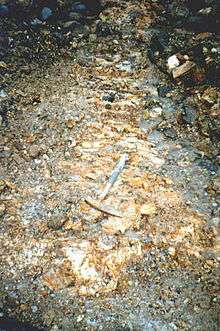
.jpg)